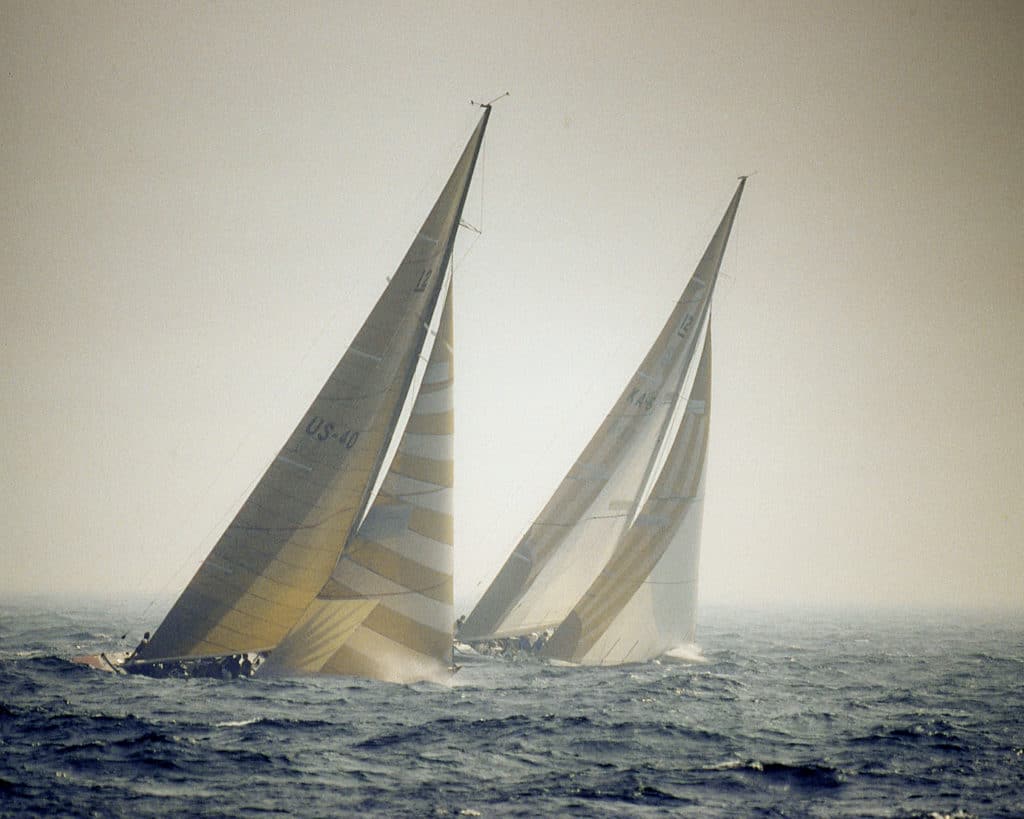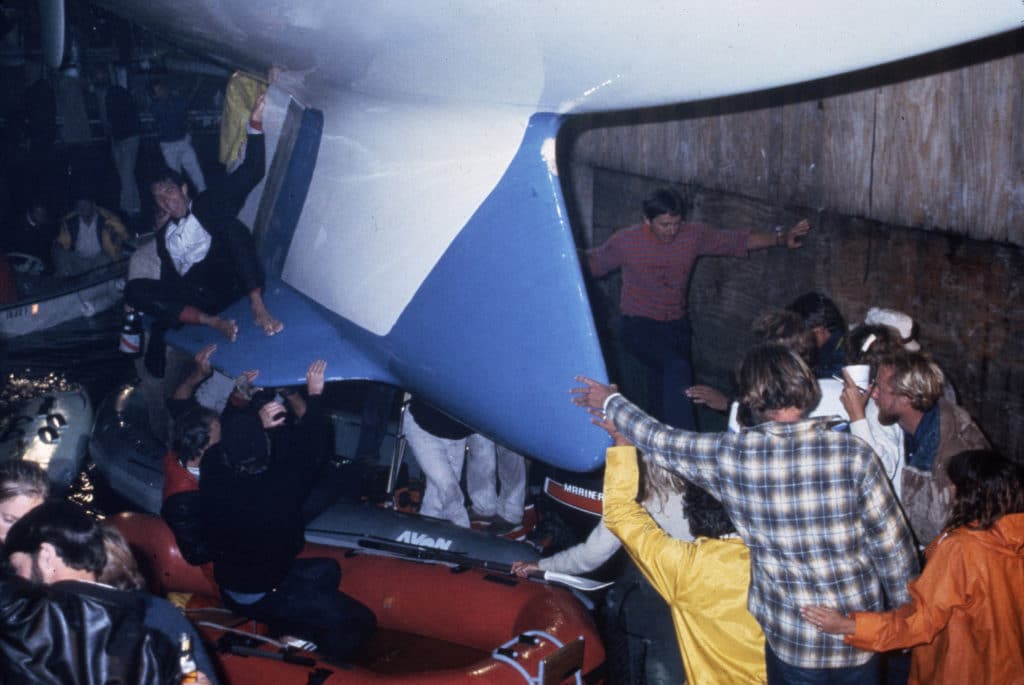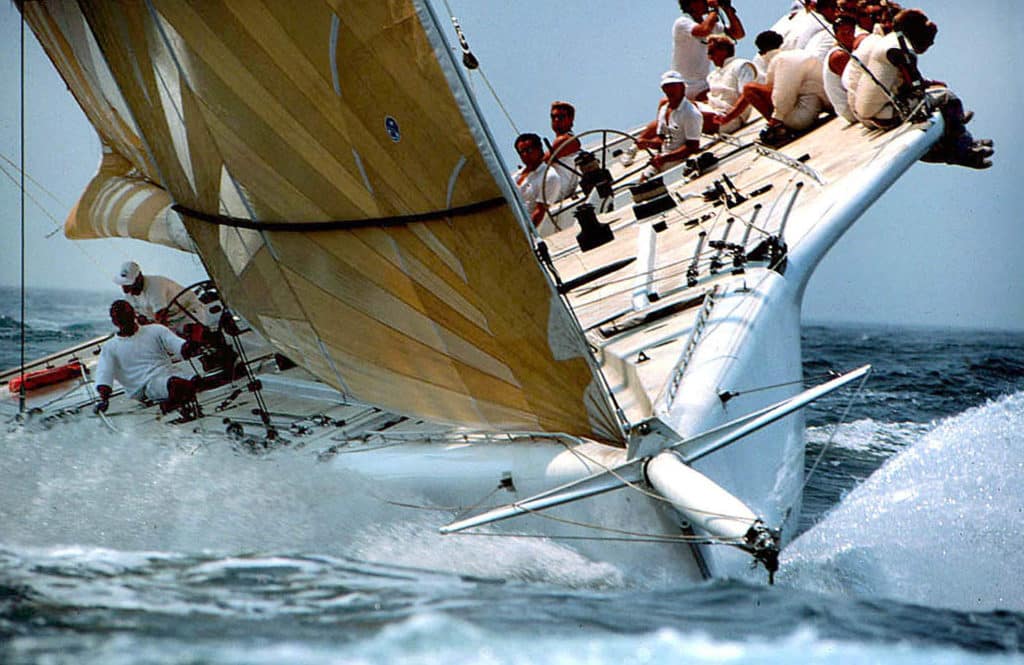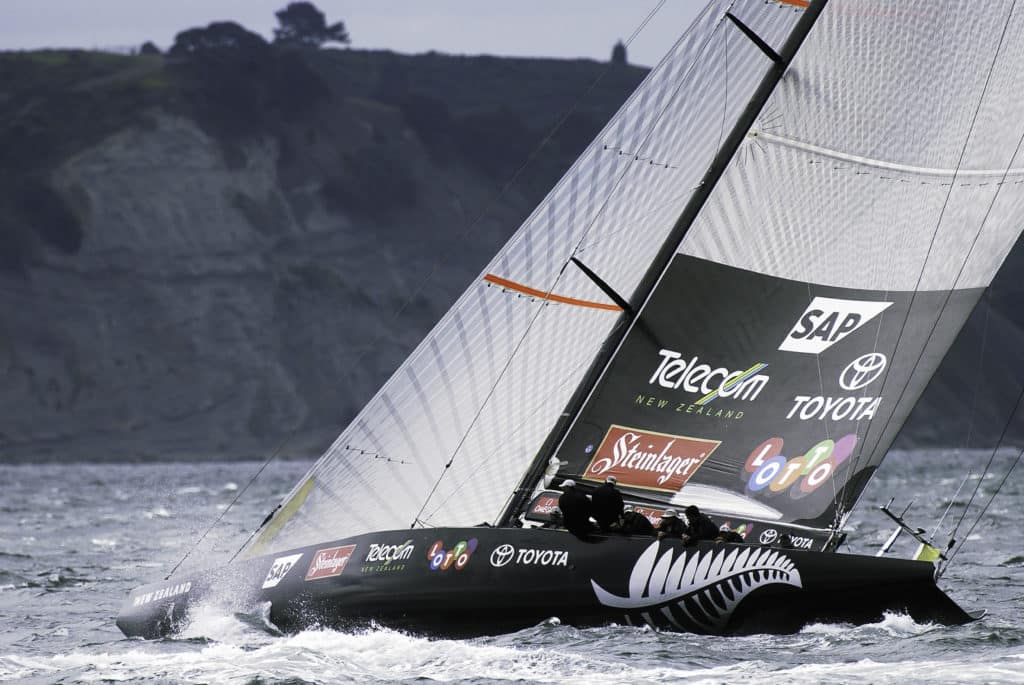
Every America’s Cup, without exception, manages to produce controversy. Most such controversies arise from one competitor challenging the complex and interpretable rules that govern the limitations of the boat. For within the constraints of the agreed-upon design rules, designers and engineers minutely examine every possible nuance to gain a superior edge in speed. And, par for the Cup, such controversies always happen behind closed doors.
No one in the America’s Cup game today is more up front and personal with generations of AC yachts than Ken McAlpine, chief measurer to the oldest trophy in sports. To say he’s seen it all is an understatement.
McAlpine began “running his tape over” America’s Cup boats in the early 1970s, back in the days when Alan Bond was noisily challenging from Western Australia. It was then that McAlpine, a qualified naval architect, came to know Warren Jones, Bond’s campaign manager at the time, for whom secrecy was a byword. Jones felt that what one’s opponent didn’t know could upset him psychologically — hence the successful keel-screening of Australia II, which other syndicates followed subsequently in one way or another.
Secrecy surrounded Australia II from the outset of the campaign — from the building process in Steve Ward’s shed in Cottesloe, Western Australia, where it could’ve been discovered that she was built close to the minimum waterline allowed by the Deed of Gift, thereby enabling the maximum sail area allowed. The 12-Meter class rule, like many others, trades the speed benefit of extra waterline length against sail area, and Ben Lexcen was sure that sail area was important after his experiments with a bendy mast had proved as much.
Australia II‘s winged keel, however, which Lexcen had validated in test tanks after completing his tests on the hull shape, would have immediately caught the eye of a curious passerby. The keel was difficult to hide for the best part of a year, even while transiting from the foundry, through the builder’s shed, and shipping to the United States, where security had to be increased daily.
The New York YC missed its chance to see the keel when Australia II was officially measured by John Savage, of Australia, Mark Vinbury, of the United States, and Tony Watts, of the United Kingdom, at Cove Haven Marina in Barrington, Rhode Island. The club’s representative, Bill Luders, had not been informed by the club of the measurement date. The original measurement for a class certificate, which should have been sufficient, was made by McAlpine before she was shipped.
“You won’t tell anyone what you have seen, will you?” was the instruction to McAlpine, who was already appraised of his need to preserve confidentiality. Today, however, he says that while the winged keel was obviously speed producing, there were other factors that would help Australia II‘s progress. “I had to check the [class] rule to clear each of them,” he says, adding, “that measurement form was the most important document I have ever signed.”
He is at pains to point out that the success of Australia II in 1983 was not down only to hull technology, but also to sail technology, notably in its spinnakers. The ones used were 3 feet narrower than those of Dennis Conner’s Liberty, and thus more stable, credit for which should go to its sail designer, Tom Schackenberg. The psychological advantage of the winged keel, however, was no doubt an element of its success.

America’s Cup 1983 Newport RI USA
The variety of 12-Meters that appeared on his doorstep in Fremantle for the next Cup series in 1987 as a result of Australia II’s success included the first fiberglass boat and Conner’s huge Stars & Stripes, which was faster as the strength of the wind increased, to win the Cup in the process. Here, once again, McAlpine was in the thick of it, drilling holes in the Kiwi Magic boats at the request of the Challenger Series organizing authority, and reportedly “over Michael Fay’s dead body.”
But the next boat to rock McAlpine was the giant New Zealand, the Michael Fay Deed of Gift challenger. Born of the mid-19th-century demands as interpreted by Bruce Farr into a late-20th-century racer, this 90-foot waterline raceboat would have been a shock to even the most sophisticated naval architect of the day. McAlpine’s first sight of the boat was when it was presented for measurement in San Diego.
Going to the maximum (for a single-masted boat) 90-foot waterline gave Farr and his partner, Russell Bowler, a broad canvas, and while the boat is now an everyday sight to visitors of Auckland’s Viaduct Basin, it was an eye-opener for McAlpine.
“I had never seen a carbon-fiber structure of this size before,” he says. It was, after all, 120 feet overall, with a beam a few inches beyond 26 feet. And that alone provided McAlpine with a challenge. “Just how were we going to measure this beast, with a draft of 21 feet and sitting on a barge, which rocked and rolled every time another boat went past?”
When the defenders, San Diego YC, announced Conner would meet the challenge from Fay’s Mercury Bay Boating Club, it resulted in a case for the New York Court of Appeals on the matter of the apparent mismatch. Fay had the support of John Bonds, the executive director of United States Yacht Racing Union, who wrote in that organization’s newsletter: “Winning is important to be sure. But it isn’t everything. Losing is preferable to cheating, to beating the rules. Winning by an unfair advantage is not preferable to losing in amateur sport.”
Nevertheless, the court ruled in favor of the “unfair” catamaran defense, and Conner’s team designed and built two 60-foot (the minimum waterline length allowed) catamarans. The game was over then and there, but the two teams had to complete the pantomime, and Conner retained the America’s Cup by 2-0 over the Deed of Gift courses. It had allowed the world to see the folly of the Cup’s ways and for a group of designers and engineers to formulate a design rule that would ensure more-competitive racing in the years to follow — the America’s Cup Class Rule (ACC).
One look at the boats that were appearing in the America3 compound for the 1993 Cup was enough to convince McAlpine (the event’s official measurer and a member of the technical committee of the rule-formulation group that gave birth to the ACC) that there was every chance that science would prevail over art in that event.

This image belongs to © WWW.OUTSIDEIMAGES.COM
Bill Koch, who gained a doctorate in fluid flow from MIT, led his team to that ideal unwaveringly. “We are now seeing boats that are not hard against the rule limitations,” McAlpine commented at the time. “Clearly Bill Koch and his team had looked at a different side of the box. Their faith in the science shone though.”
For Koch, there were no budgetary controls, and he made full use of his financial security to ring changes as and when he thought fit. Behind it all was his unwavering philosophy: “Boatspeed is a science; sailing is an art.” To start his campaign, Koch had purchased Skud from the French as a benchmark for his own designs, the first of which was Jayhawk. She was nothing more than a step along the pathway — three minutes faster around the cup course than Skud. Defiant, the third boat for the syndicate, showed another two minutes improvement, while the final scientifically designed boat, America3, was a similar advancement. McAlpine watched these successive improvements and felt certain the scientific approach would prove successful.
“All the early ACC boats were hard against the maximum beam limitation of 5.5 meters (18 feet), as the thinking at the time was that stability would drive the performance,” says McAlpine. “It was the scientific approach of the America3 syndicate that corrected this mistake. They scored by accepting the results they were obtaining from scientific experiments and then furthering them in practice. America3 was devastatingly fast straight out of the box.”
The boat entered the second round robin of the defender trials and displayed its speed, being beaten on only one occasion by its teammate Defiant in the hands of Buddy Melges. But things didn’t always go the way of this boat. A cash-strapped Conner tried desperately to become the defender and was constantly upgrading his single boat. Stars & Stripes had several keel changes, even in midseries (when this was agreed by Koch), but to no avail.
The scientifically designed America3 was superior and became the defender in 1992, by a margin of 7-4. Koch was overjoyed, Melges was muted, and it needed starting helmsman and tactician, Dave Dellenbaugh, to put the relationship between art and science into perspective. “I think our designers and everybody involved have done a great job in getting the boat to be very quick, and that makes you look smart as a tactician,” he said at the time. He was right, and America3 retained the Cup by beating Il Moro di Venezia 4-1.

It was never quite fully understood exactly what the New Zealanders were trying to achieve in 2003 with NZL 81 and 82. They were going head to head with the measurement of “length between girths” with what they called the “hula” (hull appendage), but it certainly didn’t do anything practical to improve their speed. At least, if it did, they must have been slow to begin with. Yet, their boats were developments of the highly successful NZL 60 that, in the hands of Russell Coutts, had whitewashed the challenge of Prada by 5-0. Too much time — both in the design office, and in the construction of the boats and ensuring compliance with the rules with the measurement committee — was wasted in this exercise.
During the period from March 1, 2001, to August 6, 2002, the measurement committee, with McAlpine as the ACC technical director, issued 27 Confidential Interpretations of the ACC Class Rule. They varied between materials allowed to details of standing rigging, but the most contentious concerned fixed appendages, and these had to be checked religiously each day.
ETNZ had explored a method of extending the hull waterline with an ingenious bulbous-type volume toward the aft end of the hull that was within the ACC rules. It was never fully understood exactly what the Kiwis were trying to achieve with the hula. Andy Claughton, one of the New Zealand team’s lead designer’s take on this to some extent, explains the theory with: “The hula was an attempt to combine a shallow counter with a long waterline length. The major hurdle to overcome was that the hula had to qualify as an appendage under the class rule.”
And, most important, that it qualified as an appendage by being attached only on the centerline and did not make contact with the hull at any point.
“We checked the hula every day after racing to ensure that the 1-millimeter gap between it and the hull remained, and that during the race it had not closed,” remembers McAlpine. The stresses on this appendage, resisting the buoyancy force on the hula, which acted to close the gap between it and the hull were immense, and had required mounting bolts linked to two longitudinal bulkheads in the boat’s afterbody.
While its efficacy to conform to the ACC rules was satisfied, no one in the New Zealand design nor sailing teams has ever been convincing about its speed-producing ability, but it was eye-turning when the boat was out of the water for those allowed into the New Zealand compound. NZL 82, the boat chosen to defend, did have its moments of close racing, but equipment failure in the first race against a Russell Coutts-skippered Alinghi, and the loss of her mast in the fourth, gave the Swiss team victory in five straight races.









